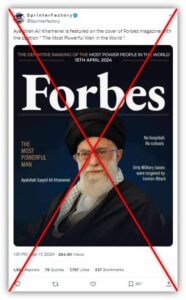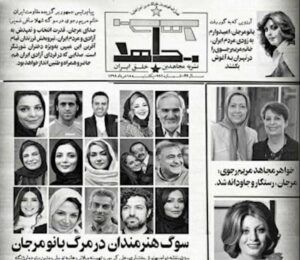AFP Fact-check on Iranian Regime’s Fabricated Forbes Cover Reveals Desperation

Iran regimes fake news
Written by
Mohammad Sadat Khansari
Two-minute read
The Agence France Presse (AFP) recently uncovered a deceptive attempt to bolster the image of the Iranian regime amidst escalating tensions in the region. An image circulated online purportedly depicted Ali Khamenei, the regime’s Supreme Leader, featured on the cover of Forbes magazine, hailed as “the most powerful man in the world.” This cover, dated April 15, emerged following the regime’s direct assault on Israel, a move that significantly heightened regional tensions already exacerbated by ongoing conflicts.
The fabricated Forbes cover, however, was quickly debunked by both the magazine itself and independent investigations. Forbes confirmed that no such edition had been published, and the image did not correspond to any of its genuine covers. Moreover, reverse image searches revealed that the photo of Khamenei used in the fake cover was not original Forbes content but rather sourced from the supreme leader’s official website in 2015. This revelation underscores the disingenuous nature of the circulated image and its intended purpose of portraying the Iranian regime as more influential than reality dictates.

These deceptive tactics are unlikely to deceive Western audiences. Instead, they will likely be exploited by the regime’s propaganda machinery and official media to bolster the sagging morale of the regime’s security forces and proxy militants. The aim will be to portray major Western media as recognizing Tehran’s power, despite the falsity of such claims.
Iran’s attempt to manipulate public perception through falsified media is not unprecedented. The regime has a history of resorting to such tactics, particularly when faced with internal or external challenges.
For instance, following the passing of renowned Iranian singer Marjan, a supporter of the People’s Mojahedin Organization (PMOI/PMOI), the regime’s Ministry of Intelligence and Security (MOIS) fabricated a replica of Mojahed, the PMOI’s journal. The fake journal included pictures of Iranian artists and athletes who had expressed condolences over Marjan’s death, a clear attempt by the regime to pressure Iranian celebrities into denouncing the PMOI.

Similarly, in 2020, a German court mandated a prominent publication in the nation to retract unfounded accusations against PMOI members residing in Ashraf 3, Albania. The journalist linked to der Spiegel was discovered to have close ties with the clerical regime, evidenced by multiple visits to Iran and state-sponsored excursions to conflict zones—a privilege typically reserved for Basij members and regime loyalists.
In times of crisis, such as the current geopolitical tensions and internal dissent faced by the Iranian regime, deception becomes a tool of survival. The Iranian regime’s resort to deception, falsification, and lying underscores its desperation to navigate through mounting challenges. As it confronts the prospect of war with Israel and the United States, along with internal discontent and international scrutiny, the regime’s reliance on fabricated media serves as a poignant reminder of its precarious position and willingness to distort reality to maintain control.

